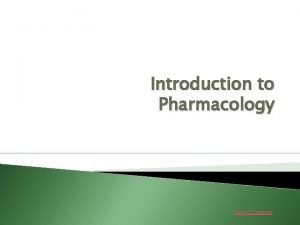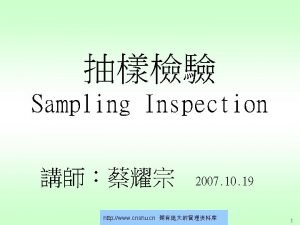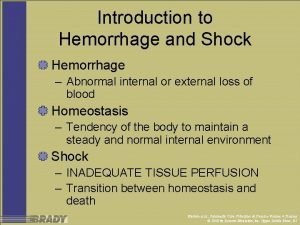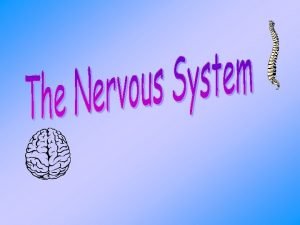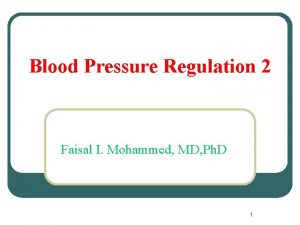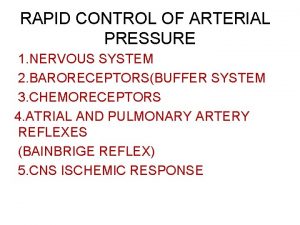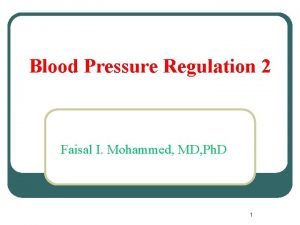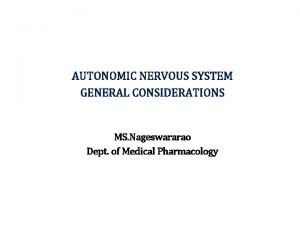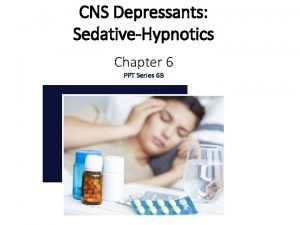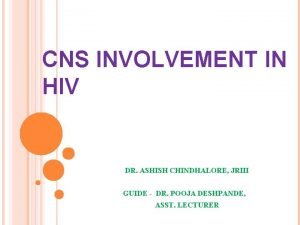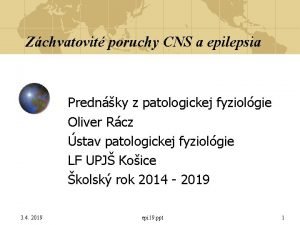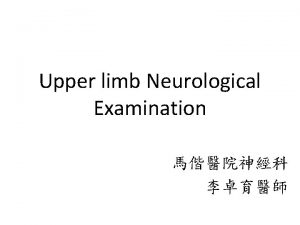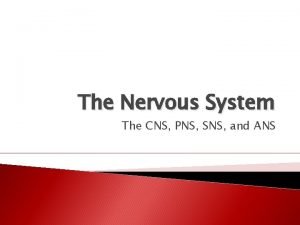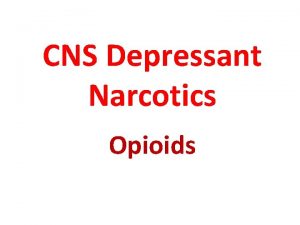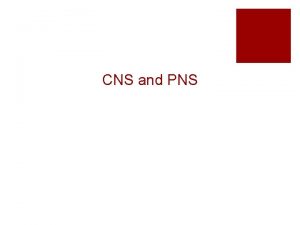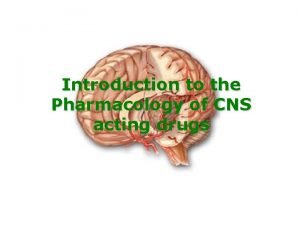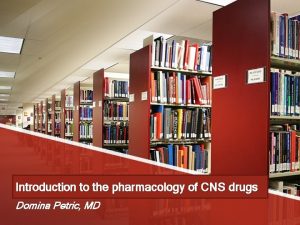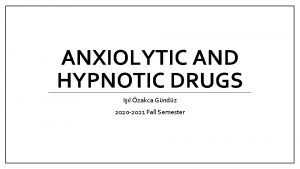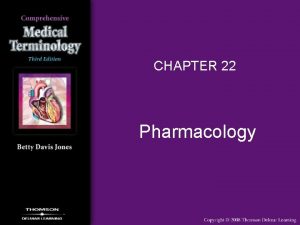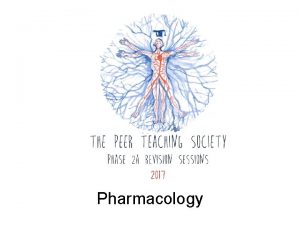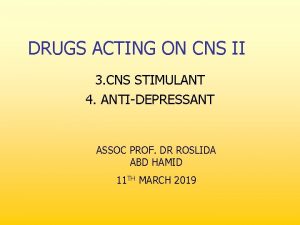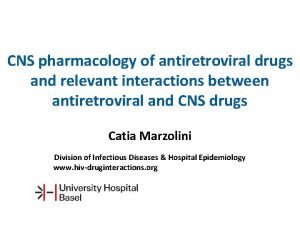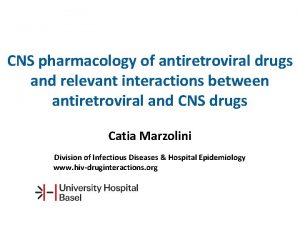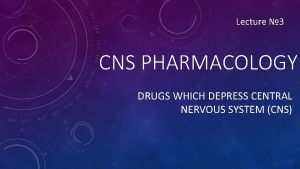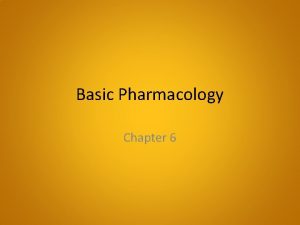INTRODUCTION TO PHARMACOLOGY OF CNS DRUGS Il zakca




















- Slides: 20

INTRODUCTION TO PHARMACOLOGY OF CNS DRUGS Işıl Özakca Gündüz 2020 -2021 Fall Semester

ORGANIZATION OF CNS

BLOOD-BRAIN BARRIER



2&3 Reserpine 5 Amphetamine Capsaisin Tetanus toxin 6 Cocaine Opioids Strychnine Ketamin 8


The selectivity of CNS drug action is based on two primary factors. 1. Different neurotransmitters are released by different groups of neurons. 2. There is a multiplicity of receptors for each neurotransmitter. Drug selectivity is based on the fact that different pathways use different transmitters. The following criteria have been established for transmitter identification. 1. Localization: A suspected transmitter must reside in the presynaptic terminal of the pathway of interest. 2. Release: A suspected transmitter must be released from a neuron in response to neuronal activity and in a calcium dependent manner. 3. Synaptic mimicry: Application of the candidate substance should produce a response that mimics the action of the transmitter released by nerve stimulation, and application of a selective antagonist should block the response.

1. Amino acid neurotransmitters: Glutamate Glycine and GABA 2. Acetylcholine 3. Monoamine neurotransmitters: Dopamine Noradrenaline 5 -hydroxytryptamine Histamin 4. Neuropeptides 5. Other: Endocannabinoids Nitric oxide Purines

GLUTAMATE Excitatory Ca+2 -dependent exocytosis. Glutamate transporters. Vesicular glutamate transporter (VGLUT). Ionotropic receptors: AMPA (Na, K) KA (Na, K) NMDA (Ca, Na, K) Glutamate must bind to the receptor. Membrane must be depolarized. Long-term potentiation (LTP). Metabotropic receptors: Group I: Postsynaptic, PLC activation, IP 3 -mediated intracellular Ca release. Group II Presynaptic. Inhibition of Ca channels, inhibiton of neurotransmitter synthesis. Negative Group III feed-back.

GLYCINE AND GABA Inhibitory Pentameric structures that are selectively permeable to Cl. Strychnine: Glycine receptor blocker, potent convulsant. GABA receptors: GABAA and GABAB GABAA: Fast component of inhibitory postsynaptic potential. Ionotropic receptors. Selective permeable to Cl- channels. Subunits of GABAA clinically important. GABAB: Slow component of inhibitory postsynaptic potential. Metabotropic receptors. Inhibition of Ca+2 channels or activation of K+ channels. Inhibitory postsynaptic potential is long-lasting and slow. • Inhibition of neurotransmitter release via inhibition of Ca+2 channels. • Inhibition of adenylyl cyclase and c. AMP production.

ACETYLCHOLINE (ACH) First compound to be identified as a transmitter in the CNS. Most CNS responses to Ach are mediated by a large family of G protein-coupled muscarinic receptors. ACh causes slow inhibition of the neuron by activating the M 2 subtype of receptor, which opens potassium channels. A far more widespread muscarinic action in response to acetylcholine is a slow excitation that in some cases is mediated by M 1 receptors. Alzheimer: Ach neurons are located in certain areas to play an important role in cognitive functions. Presenile dementia of the Alzheimer type is reportedly associated with a profound loss of cholinergic neurons.

MONOAMINE NEUROTRANSMITTERS: Dopamine, noradrenaline, 5 -hydroxytryptamine and histamine. These pathways are the site of action of many drugs; for example, the CNS stimulants cocaine and amphetamine appear to act primarily at catecholamine synapses. Cocaine blocks the reuptake of dopamine and norepinephrine, whereas amphetamines cause presynaptic terminals to release these transmitters. DOPAMINE Slow inhibitory action Parkinson treatment Project linking the substantia nigra to the neostriatum Antipsychotic drugs Project linking the ventral tegmental region to limbic structures Five dopamine receptors have been identified and they fall into two categories: D 1 -like (D 1 and D 5) and D 2 -like (D 2, D 3 and D 4). All dopamin receptors are metabotropic receptors.

NORADRENALINE All noradrenaline receptors are metabotropic receptors. Noradrenaline can hyperpolarize neurons by increasing potassium conductance. This effect is mediated by alpha 2 receptors In many regions of the CNS, norepinephrine actually enhances excitatory inputs. • Indirect mechanism involves disinhibition • Direct mechanism involves blockade of K+ conductances (via alpha 1 or beta-adrenoceptors) 5 -HYDROXYTRYPTAMINE All 5 -HT receptors are metabotropic receptors except 5 -HT 3 subtype. The ionotropic 5 -HT 3 receptor exerts a rapid excitatory action at a very limited number of sites in the CNS. In most areas of the CNS, 5 -HT has a strong inhibitory action. This action is mediated by 5 -HT 1 A receptors and is associated with membrane hyperpolarization caused by an increase in K+ conductance Both excitatory and inhibitory actions can occur on the same neuron. 5 -HT has been implicated in the regulation of virtually all brain functions, including perception, mood, anxiety, pain, sleep, appetite, temperature, neuroendocrine control, and aggression

HISTAMINE They modulate arousal, attention, feeding behavior, and memory. There are four histamine receptors (H 1 to H 4), all of which are metabotropic. Centrally acting antihistamines are generally used for their sedative properties and antagonism of H 1 receptors is a common side effect of many drugs including some tricyclic antidepressants and antipsychotics.

NEUROPEPTIDS: Opioid peptides (eg, enkephalins, endorphins), neurotensin, substance P, somatostatin, cholecystokinin, vasoactive intestinal polypeptide, neuropeptide Y, and thyrotropin-releasing hormone. Unlike the classical neurotransmitters above, which are packaged in small synaptic vesicles, neuropeptides are generally packaged in large, dense core vesicles. Peptides often coexist with a conventional nonpeptide transmitter in the same neuron, but the release of the neuropeptides and the small molecule neurotransmitters can be independently regulated. Most neuropeptide receptors are metabotropic. Neuropeptides have been implicated in reproduction, social behaviors, appetite, arousal, pain, reward, and learning and memory.




 Pharmacology of drugs acting on respiratory system
Pharmacology of drugs acting on respiratory system Adrenal drugs pharmacology
Adrenal drugs pharmacology Slidetodoc. com
Slidetodoc. com Therapeutic index
Therapeutic index Cns2779
Cns2779 Naas community national school
Naas community national school Haemorrhage
Haemorrhage Cns histology ppt
Cns histology ppt Composition of cns
Composition of cns Cns ischemic response
Cns ischemic response Mean bp formula
Mean bp formula Bainbridge reflex
Bainbridge reflex Www.lispa.it cns
Www.lispa.it cns Ans and cns difference
Ans and cns difference Cns depressants ppt
Cns depressants ppt Tuberculomas
Tuberculomas Depresori cns
Depresori cns Cns international school
Cns international school Cns poruchy
Cns poruchy Grading of reflexes
Grading of reflexes Dermatomes
Dermatomes


